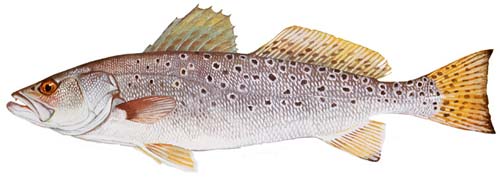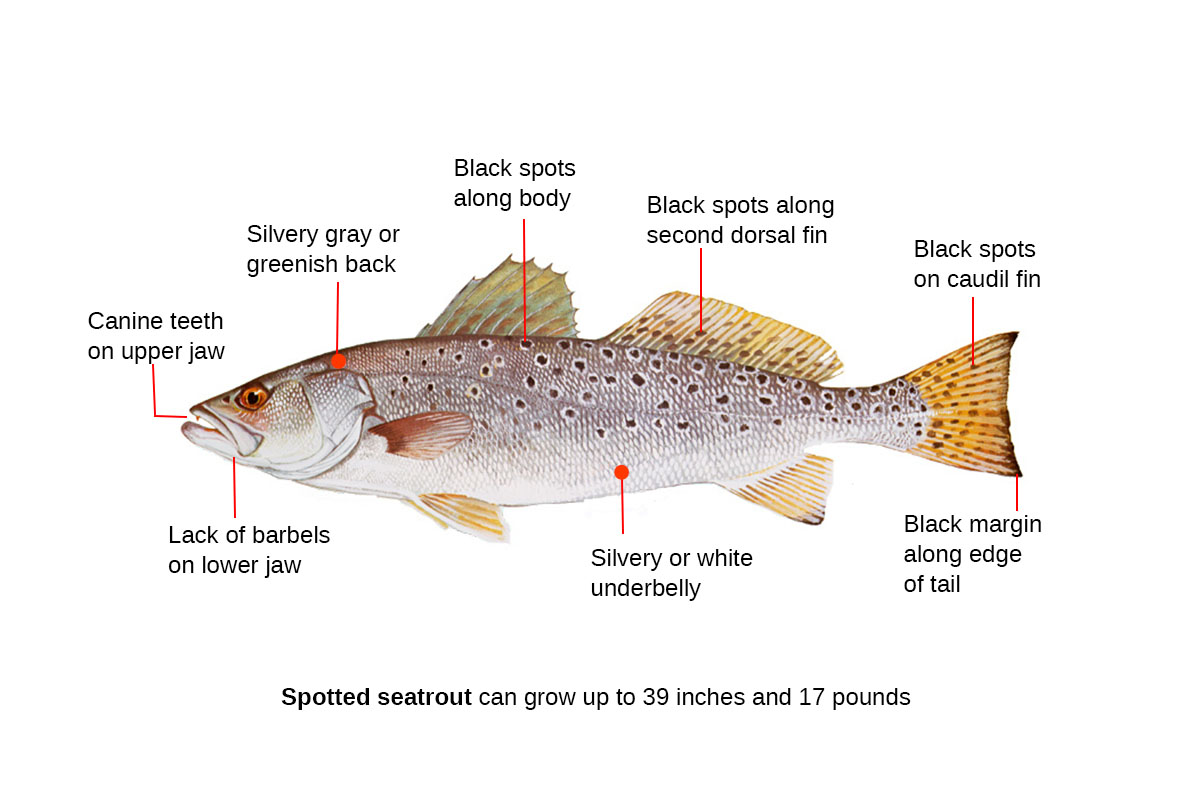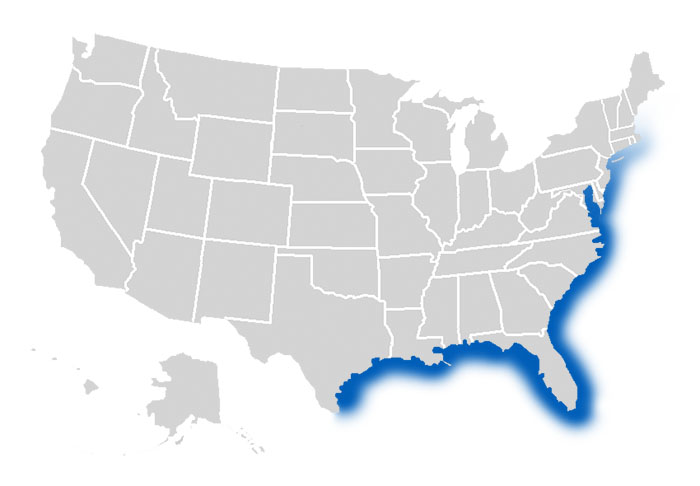The spotted seatrout, also known as the speckled trout, is a popular sport fish that can be found along the coastline in the Atlantic Ocean. Some effective methods for catching spotted seatrout include drift fishing, fly fishing, saltwater jigging, still fishing, and top water fishing. These fish prefer bait, especially shrimp.

Habitat: Bay, Ocean
Spotted trout, also known as Speckled trout, is excellent tablefare which makes the a highly prized gamefish. Spotted trout aren’t the hardest fighting fish, but they make for a fun family angling adventure.
- How to identify Spotted Seatrout
- Range and habitat
- Where to catch Spotted Seatrout
- How to catch Spotted Seatrout
- Best Baits and Lures
- Recommended Tackle
How to identify Spotted Seatrout
The spotted seatrout has a silvery gray or greenish upper body with a white belly. There is a black margin along the outer edge of the caudil fin. It has a pointed snout, elongated body, and a lower jaw that extends outward. There are two canine teeth at the tip of the upper jaw.

As their name implies, spotted seatrout have well-defined black spots on the upper body, second dorsal fin and tail.
Identifying characteristics:
- Silvery gray or greenish back
- Silvery or white underbelly
- Black spots along body
- Black spots along second dorsal fin
- Black spots on caudil fin
- Canine teeth on upper jaw
- Lack barbels on lower jaw
- Black margin along edge of tail
- Soft dorsal fin with no scales
Adult spotted seatrout average 22 inches and about 3 pounds. They may reach 39 inches and up to 17 pounds.
Range and habitat
Though it is most plentiful along the coasts of North Carolina and Texas, the spotted seatrout can also be found all along the Atlantic coastline as far north as Long Island, New York, and as far south as the Yucatan peninsula.

During spring and summer, spotted seatrout are most often found in the shallow waters of estuaries, tidal rivers, coastal bays, and sometimes along the surf. They’ll often seek cover in seagrass beds, oyster beds, and structure.
As water temperatures cool in late Autumn, spotted seatrout move into deeper bays and waters off the Gulf of Mexico. As waters warm in the spring, they migrate back to the shallow bays and estuaries along the coast.
During periods of low rainfall and runoff, it’s not uncommon for seatrout to move into deeper rivers, channels and harbors at first signs of cool fall weather. This provides anglers short window of time to target spotted seatrout nearshore.
The following are habitats where you can catch Spotted Seatrout:
- Backwater Fishing
- Bays
- Estuaries
- Channel Entrances
- Current Edges
- Drop-offs
- Eddies
- Man-made Structures
- Ripples, Currents, Swirls and Sprays
- Rock and Boulder Pockets
- Saltwater Tides
- Saltwater Weed Beds
- Schools
- Small Pointed Waves
Where to catch Spotted Seatrout
The first step to catching spotted seatrout is finding them. During warm weather fish the nearshore shallows in the early mornings and late evenings. During mid day, or when the weathers is colder, target the deeper areas of bays, grass flats, channels, dropoffs, harbors, and oyster reefs. The deeper area are typically full of spotted seatrout just after a “norther” (strong cold north autumn wind) has subsided and weather is warming.
During the summer and fall, target flocks of gulls feeding on small fish at the water’s surface. Schools of seatrout chase small fish and shrimp to the surface which attracts the gulls. You’ll often see the trout just under the water’s surface in a flury of action as they feed. Fishing your presentation at the edge of the feeding frenzy will often generate hookups.
Some anglers report one of the best ways to locate spotted seatrout is to “sniff” them out. That’s right, sniff. Seatrout regularly regurgitate partially digested foods and oils which rise to the surface creating a visible slick that puts off an distinguisable odor. Anglers describe the odor as something akin to the smell of grass that has just been mowed.
Hotspots for spotted seatrout will vary from one location to the next. It’s always a good idea to check with local bait and tackle shops, and local anglers, to find out where the fish are biting.
How to catch Spotted Seatrout
The feeding habits of spotted seatrout vary according to their size. Small spotted seatrout feed almost exclusively on crustaceans. Mid-size trout feed on small baitfish and shrimp. Large seatrout feed primarily on larger fish such as pinfish, mullet, pigfish and menhaden. Large seatrout are infrequently targeted by anglers due to bait requirements.
There a number of techniques and tactics used by anglers to catch seatrout. Below we’ll outline basic, yet effective, methods for targeting seatrout. As you gain experience fishing for seatrout, you can improve upon these methods to build your own techniques for catching seatrout.
There are a number of artificial lures that seatrout will take but hands down the best bait for catching spotted seatrout is live shrimp. If live shrimp is available, it’s your best bet. The most popular presentation for fishing spotted sea trout is the popping cork rig. Hook a live shrimp on a popping cork rig and you’ll catch seatrout if there are any.
If shrimp aren’t available, DOA shrimp baits or soft plastic lures that mimic shrimp are also productive for fishing seatrout. Seatrout like action, so if you’re fishing artificial lures, you’ll want to pop your cork occasionally to similute live action. Live fish such as pinfish or mullet can also work for bait if shrimp isn’t available.
An alternative presentation to the popping cork rig is a “free shrimping rig”. A free shrimping rig is created by removing the cork from the popping cork rig and replacing the heavier sinker will a light weight. Using a shrimp, lure, or fish as bait, the free shrimping rig is then drift fished along the bottom while the bait drifts freely in the water.
Other productive presentations for fishing seatrout feeding near the bottom include bottom fishing rigs such as a knocker, split shot, or drop shot rig. Bottom fishing rigs can be fished with the same baits used for popping cork and free shrimping rigs.
When seatrout are feeding near the top of the water column, or in shallow flats and oyster bars during high tide, a topwater plug that mimics an injured baitfish will readily attract strikes from larger seatrout.
Trout can also be targeted near inshore waters fishing a fly. Anglers can use the same fly patterns and colors used for fishing red drum and snook to target seatrout. Simple streamers that mimic natural forage fish are ideal. Anglers report white or natural colored flies are preferred by seatrout.
Fishing from boat is the most common approach for targeting seatrout, but wade or surf fishing is also productive. Flat skiffs are the vessel of choice for fishing seatrout in nearshore waters, but johnboats and kayaks will also get the job done. Regardless of the type of boat, or system or propulsion, you want to maintain a slow, steady drift that will allow you to cover a lot of area without scaring away fish.
When wade fishing or surf fishing for seatrout the key is to get your bait out beyond the surf where it can be seen by foraging seatrout. Having a good surfing rod that will enable long casts is essential. Since spotted seatrout are visual feeders, you get more hookups when water clarity is high. Good water clarity and calm winds are ideal conditions for wade fishing or fishing the surf.
The following are common fishing methods and techniques for catching Spotted Seatrout:
Best Baits and Lures
Shrimp is the preferred and most effective bait for catching a spotted seatrout. Live minnows, pinfish, mullets, piggy perch, croaker and peeler crab are also effective baits. Spotted seatrout can also be caught using various artificial lures including jigs, spoons, swimbaits, shrimp like lures, as well as lures that mimic baitfish or flys.
Jigs can be fished suspended under a cork or free style. They can be fished singly or in pairs. Jigs are most effective when seatrout congregate to feed. A long shank 1/8 or 1/4 oz jig worm is especially effective when fished in grassy flats where you know there are schooling seatrout.
Silver spoons of varying sizes and weights are also productive for fishing seatrout. They tend to perform best during warmer months when seatrout are most active. Test different sizes, depths and retrieve rates to see which combination works best for the area you’re fishing. A double dropper style rig where a spoon is fished with a bucktail trailing about 18 inches behind gets seatrout biting.
Lures that mimic baitfish retrieved slow tend to perform especially well during cold weather—although they can be productive year round. To keep the lure off the bottom when using a slow retrieve in the shallows, anglers will often attached the line to the snout tip instead of the lure head. Topwaters can be used to target larger seatrout when fishing the shallows during warmer summer months.
When fishing with live baitfish, run a 2/0 to 3/0 Kahle hook through the nose or through the back along the lateral line. This will keep the baitfish alive and allow it to swim naturally.
The following are fishing lures, bait and tackle that can be used to catch Spotted Seatrout:
Recommended Tackle
One of the nice things about seatrout fishing is that you don’t need heavy tackle. Average seatrout range from 2-3 pounds. A light to medium action salt water rod and reel combination is all that is required for fishing a trout of this size. You can use a casting or spinning rod. You want want a light yet sturdy rod that will allow for long distance casting large topwater lures, plastic baits and whoe live fish.
Make sure you’re using corrosion resistent equipment that is designed for salt water.
Any line will work for fishing seatrout, but braided line will help you better feel when something hits your line.
Seatrout have sharp teeth so it’s a good idea to have a pair of lip grippers for removing hooks without cutting your fingers or harming the trout.



